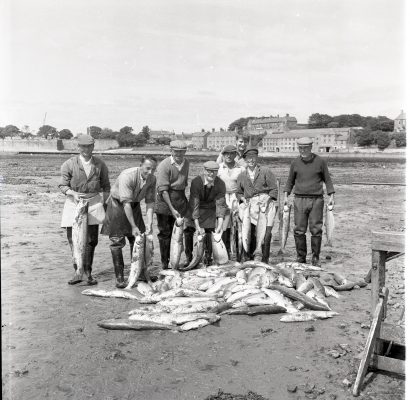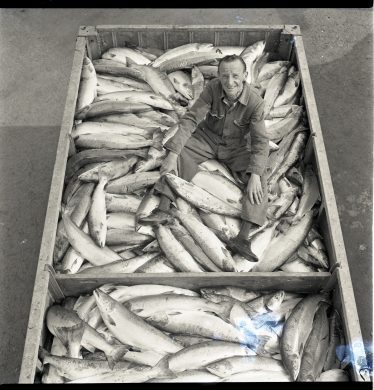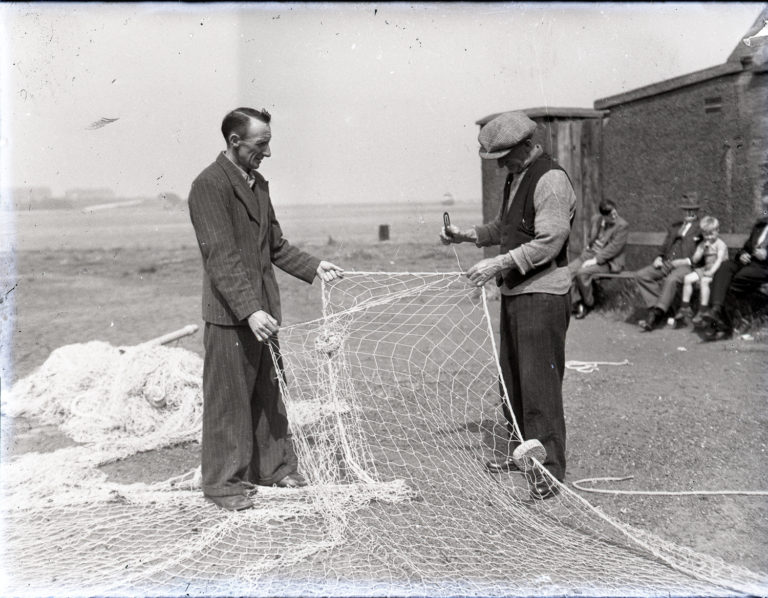Photographs of the Fishing Industry, 1952-1969
Reference: BRO 1944/1/ 5341/66, BRO 1944/1/4852/39, BRO 1944/1/271/6, BRO 1944/1/291/9
Suggested age groups: KS2, KS3, KS4, KS5, Lifelong Learners
Subject areas: Environmental portraiture, Photography, Industry
CONTEXT
Originally founded in 1951 as the Photo-News Service, the Photo Centre in Berwick was a staple of town life for over 65 years as a family-run press agency and photo studio.
Their premises at 17 Bridge Street had a well-equipped studio above the shop where commercial photography took place. The business also covered newsworthy events in the area and recorded family occasions and celebrations, marking milestones in the lives of several generations of townspeople.
Salmon fishing on the River Tweed and at its mouth at Berwick has been carried on since the medieval period. The river was and still is divided into a series of fisheries on both banks, all individually named – including Crabwater; Gardo, Abstell, Yarrow and Sandstell.
Until the late 18th century, salmon were often pickled or salted to preserve them. They were packed in barrels and then transported by ship to London and other places. However, this all changed in 1788 when it was discovered that the salmon could be packed in ice in flat boxes to keep them fresh and then sent to London in fast Berwick boats known as “Smacks”. These boats could sail there in as little as 44 hours.
Fishing for salmon on the River Tweed was and still is governed by various Tweed Fisheries Acts. These regulated the times when fishermen could fish – they are not allowed to fish between 6pm on Saturdays and 6am on Monday mornings and no fishing with a net is allowed between 14th September and 15th February.
In the 19th and 20th centuries salmon fishing was a major employer in Berwick. One of the main companies was the Berwick Salmon Fisheries Company which operated until 1988. By then the salmon industry in Berwick was in decline as many of the fishery rights had been bought up by the Atlantic Salmon Conservation Trust and others. As of 2021, there is only one commercially operated salmon fishery at the mouth of the River Tweed – Gardo – near Tweedmouth Dock which catches the fish the traditional way with a net and coble.
The first photograph (BRO 1944/1/4852/39), taken on 25 July 1967, shows fishermen displaying their large catch of 102 salmon at Outwaterstell Fishery near the mouth of the River Tweed.
On 8th August 1969, a tally of 361 salmon, 448 grilse and 23 trout were caught over one tide and an 8-hour spell of fishing at Crabwater Fishery. This total of 832 fish was the largest local catch ever recorded in one day. This second image (BRO 1944/1/5341/66) shows Mr Swinney sitting in his truck with the catch.
The third photograph (BRO 1944/1/271/6), taken in 1952 shows a salmon fishing net being made at the Carr Rock in Spittal. The net is being sewn to the float rope and the corks came from Portugal.
The final photograph (BRO 1944/1/219/9), also taken in 1952 shows boxes of Tweed salmon being delivered to Berwick Railway Station, ready for their onward journey to London and other places by rail. This was the quickest way to transport them.
An environmental portrait is a photograph of someone in their usual environment, for example at home, in their workplace, or in an area that typically shows as aspect of the subject’s everyday life. The essence of environmental portraiture is to capture the subject in the context of their surroundings. The surroundings or background of the portrait is a key element as this is used to give further information about the person being photographed. The subject is often shown undertaking their usual tasks, such as doing an element of their job.
ARTISTS BANK
August Sander
Described as “the most important German portrait photographer of the early twentieth century”, August Sander spent his life documenting his fellow countrymen in straightforward, dignified portraits picturing farmers, merchants, civil servants, intellectuals, gypsies, and the insane so that they could be seen.
Example environmental portraiture images: Berlin Coal Carrier, 1929; Young Farmer, 1912-13; Farmer Working in the Fields, c.1930
Arnold Newman
Newman was credited with popularising environmental portraiture, a style that captures subjects in their surroundings and uses significant details to communicate their profession and personality. His environmental portraits mainly consisted of artists and politicians. He was also known for his carefully composed abstract still life images.
Example environmental portraiture images: Igor Stravinsky, 1946; Pablo Picasso, 1954; Andy Warhol, 1973
Alfred Eisenstaedt
German-born American photographer is best known for his candid black-and-white shots of celebrities, politicians, and captivating street shots.
Example environmental portraiture images: Gondolas, Venice, 1947; George Bernard Shaw at Typewriter, 1932; General Electric Turbine Plant, 1948
Jimmy Nelson
British photographer Jimmy Nelson focuses on taking environmental portraits of indigenous people from tribes that are about to disappear.
Environmental portraiture portfolio: https://www.jimmynelson.com/
ACTIVITIES
ACTIVITY 1
Background
Salmon fishing on the River Tweed and at its mouth at Berwick has been carried on since the medieval period.
Fishing for salmon on the River Tweed was and still is governed by various Tweed Fisheries Acts. These regulated the times when fishermen could fish – they are not allowed to fish between 6pm on Saturdays and 6am on Monday mornings and no fishing with a net is allowed between 14th September and 15th February.
In the 19th and 20th centuries salmon fishing was a major employer in Berwick. One of the main companies was the Berwick Salmon Fisheries Company which operated until 1988. By then the salmon industry in Berwick was in decline as many of the fishery rights had been bought up by the Atlantic Salmon Conservation Trust and others. As of 2021, there is only one commercially operated salmon fishery at the mouth of the River Tweed – Gardo – near Tweedmouth Dock which catches the fish the traditional way with a net and coble.
SEE
See: What type of fishing has been carried out in Berwick since the medieval period?
See: Who governs fishing on the River Tweed?
See: When is fishing not permitted on the River Tweed?
See: When was salmon fishing a major employer in Berwick?
See: When did the salmon industry decline in Berwick?
THINK
Think: Why did the salmon fishing industry decline in Berwick?
Think: Why are fishing times on the River Tweed restricted?
Think: Why does the fishing industry need regulations?
Think: Why is salmon fishing mostly done by rod now rather than by net?
Think: Are there any environmental concerns about salmon fishing?
Think: What are salmon farms and why were they introduced?
Think: What were the main industries in Britain during the mid-20th century?
Think: How do these industries differ from what came before them?
Think: What are the main industries in Britain today?
Think: What do you think are the main industries in Berwick today?
Think: How important is Britain’s fishing industry?
Think: What impact does the fishing industry have on the environment?
DO
Do: Research your local area. What was the dominant industry in your area during the mid-20th century?
Do: Research what the dominant industries are in your area today.
Do: In groups discuss what you think the dominant industry will be in your area 30 years from now.
Do: Imagine you are living 30 years in the future. Think about the industrial past of your area, along with its natural environment and transport connections. Make a proposal for a new industry in the area.
Do: Research the fishing industry in Britain today. Create a poster showing the major challenges the industry is currently facing.
Do: Create a poster showing the environmental impact of the fishing industry.
Do: Come up with a proposal of ways to make the fishing industry more environmentally friendly.
Do: In groups, debate the impact of Brexit on Britain’s fishing industry.
Do: Write a newspaper article to tell the story of one of the photographs.
Do: Debate the impact of salmon fishing becoming a sport for the wealthy rather than being a major employer.
Do: Discuss the impact the decline of the salmon industry might have had on Berwick and its employment climate.
Do: Create a survey comparing Berwick’s main industries and employers during the 1950s to the main industries and employers in Berwick today. Write a case study about the changes over time based on your findings.
Do: Watch Richard Dimbleby’s 1950 short documentary Travelogue of England’s Far North Town (BFI, 1952). What can you learn about Berwick’s salmon fishing industry from the video? – https://player.bfi.org.uk/free/film/watch-come-with-me-berwick-upon-tweed-1952-online. It can be viewed for free.
Resources
https://the-environment.org.uk/bristish_isles/industrial_fishing_UK_history.html
https://www.nature.com/articles/ncomms1013
https://britishseafishing.co.uk/brexit-and-britains-fisheries/
https://animalequality.org/blog/2019/09/30/fishing-industry-destroying-environment/
https://www.sustainweb.org/goodcatch/environmental_impacts/
https://player.bfi.org.uk/free/film/watch-come-with-me-berwick-upon-tweed-1952-online
ACTIVITY 2
Background
An environmental portrait is a photograph of someone in their usual environment, for example at home, in their workplace, or in an area that typically shows as aspect of the subject’s everyday life. The essence of environmental portraiture is to capture the subject in the context of their surroundings. The surroundings or background of the portrait is a key element as this is used to give further information about the person being photographed. The subject is often shown undertaking their usual tasks, such as doing an element of their job.
SEE
See: What is an environmental portrait photograph?
See: What are the main characteristics of an environmental portrait?
See: What is shown in each of these photographs?
THINK
Think: What can you learn about the subjects in each of these photographs?
Think: What do you think the purpose of these photographs is?
Think: Are the photographs candid or posed?
Think: What equipment and techniques do you think were used to take these photographs?
Think: Do you think these photographs are good examples of environmental portraiture?
DO
Do: Choose an industry in your local area. Create a series of environmental portraits focusing on that industry.
Do: How would you photograph subjects differently depending on the industry or environment they are in? Design a series of shoots planning how you would capture subjects in different environments.
Do: Shadow someone for the day in the style of Sophie Calle, this could be a friend or family member for example. Produce a series of environmental portraits showing someone in the different day to day aspects of their life.
Do: Think about how different palettes of colours, shades and tones are associated with different industries, professions, and environments. Create a mood board showing ranges of colours, shades, and tones in environmental portraits.
Do: Using your mood board, annotate and analyse which palettes are associated with which industries, environments, and professions.
Do: Experiment with taking photographs using different colour, shade, and tone palettes.
Do: Experiment with taking high-key and low-key images.
Do: Create your own environmental portraiture series working in your own style with your own theme, using palettes of colour, shade, and tone to express the environment, industry, or profession.
Resources
https://medium.com/@pixelmagazine/color-theory-for-photographers-an-introduction-ae23296fda6d
https://digital-photography-school.com/limited-color-palette-strong-images/
https://photographycourse.net/environmental-portraits/
https://fstoppers.com/education/closer-look-high-key-and-low-key-photography-547770
OTHER ONLINE RESOURCES
Early Photography
Science Museum website, page about history of photography: https://www.scienceandmediamuseum.org.uk/objects-and-stories/history-photography
British Library website, page about invention of photograph (Henry Fox Talbot): https://www.bl.uk/collection-items/invention-of-photography
Bodleian website, biography of Henry Fox Talbot: https://talbot.bodleian.ox.ac.uk/talbot/biography/
Photo Centre
Portrait of a Town exhibition: https://www.photocentreberwick.co.uk/portrait-of-a-town/work-and-industry
Photo Centre workshop resources: https://www.photocentreberwick.co.uk/learning
Environmental Portraiture
Headshot London blog, What is Portraiture? – https://www.headshotlondon.co.uk/blog/what-is-a-portrait-photography/
History of Photography, Portraits – https://notquiteinfocus.com/2014/10/16/a-brief-history-of-photography-part-11-early-portrait-photography/
Tate, Portraiture – https://www.tate.org.uk/art/art-terms/p/portrait
How portrait photography evolved over time – https://www.scancafe.com/blog/the-evolution-of-portrait-photography
Industry in Berwick
Salmon fishing in Berwick – http://www.berwickfriends.org.uk/history/north-northumberlands-industrial-heritage/salmon-fishing-in-berwick-upon-tweed/
North Northumberland’s industrial heritage – http://www.berwickfriends.org.uk/history/north-northumberlands-industrial-heritage/
Publications about Salmon fishing in Berwick
Wake for the Salmon: Jim Waller. Published by Northumberland County Libraries 1988 ISBN 10: 095130271 ISBN 13: 9780951302712
By Net and Coble – salmon fishing on the River Tweed: Jim Walker. Published by Blackwall Press 2006 ISBN-10: 0955210917 ISBN-13: 978-0955210914





